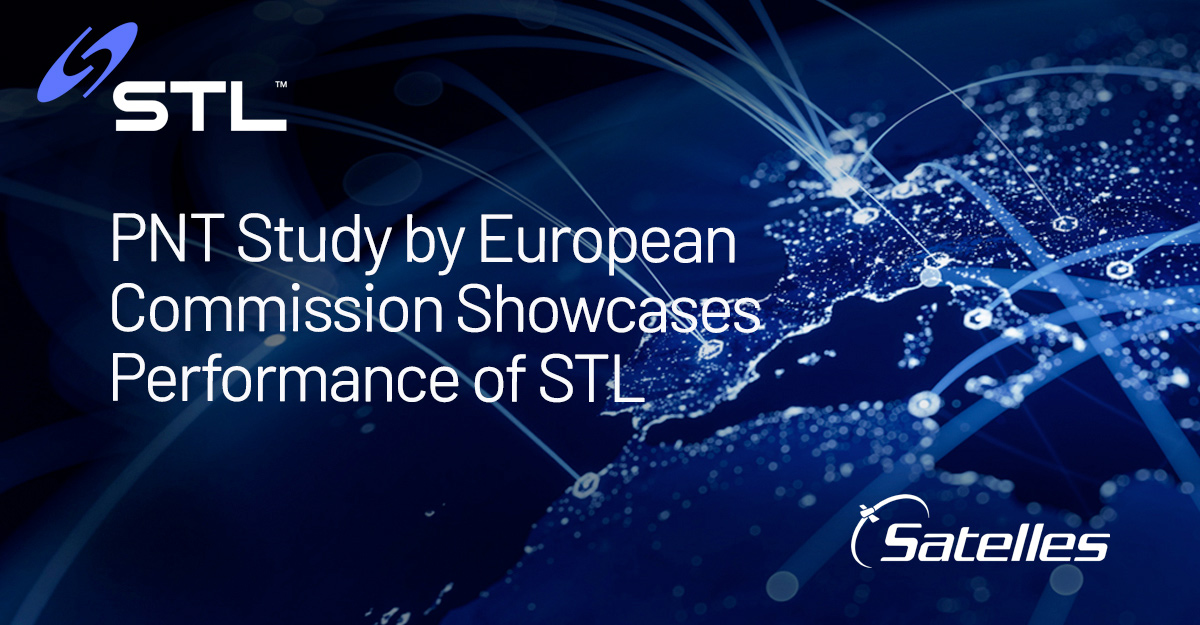Results from on-site test with Satelles and VIP demonstration in Italy exceed expectations for complementary technology to GNSS in Europe
RESTON, Va., March 27, 2023 – Satelles, Inc. (www.satelles.com), innovative provider of highly secure satellite-based time and location services, today announces the outstanding performance of Satellite Time and Location (STL) in a broad evaluation of positioning, navigation, and timing (PNT) technologies by the European Commission’s Directorate-General for Defence Industry and Space (DEFIS). Satelles was one of six companies — and the only U.S.-based firm — awarded a competitive contract by DEFIS in October 2021 to participate in a demonstration and study of alternative PNT technologies at the EC’s Joint Research Centre (JRC) in Ispra, Italy.
As stated by the EC, the aim of this project was to “analyse the technologies which could deliver positioning and/or timing information independently from GNSS, to be effective backup in the event of GNSS disruption, and if possible, to be able to provide PNT in the environments where GNSS cannot be delivered.” The JRC conducted their tests of STL in late 2021 and early 2022 and subsequently arranged a demonstration day for all test participants in May 2022 that was attended by EC government officials and other dignitaries with backgrounds in PNT, metrology, and critical infrastructure.
In the final report just released to the public, the EC details its conclusions from the demonstration, with STL — a globally available alternative PNT service from low Earth orbit (LEO) satellites — exceeding expectations for the EC’s top-level performance requirements. In the months following the EC demonstrations, Satelles has continued to optimize the STL technology, achieving results as low as 26 nanoseconds at 1 sigma.
Outdoor Static Timing Test. The JRC studied STL while operating in the absence of a signal from Global Navigation Satellite Systems (GNSS), such as the U.S.-operated Global Positioning System (GPS) or the European Union-managed Galileo system, for progressively longer periods of 1, 14, and 100 days. Using a traditional exterior roof-mounted antenna, STL achieved remarkable accuracy relative to Coordinated Universal Time (UTC) across all test intervals with 100% availability and exceptional timing stability. For the 100-day test, STL produced an incredible frequency stability (Allan deviation) of 2.28E-13 — all while operating with 100% availability for the duration of the test.
Indoor Static Timing Test. JRC testing also included two scenarios with a small indoor antenna located in the center of the ground floor of a large building at the JRC facility. In both placements (with the antenna on top of a filing cabinet and inside the filing cabinet for a separate trial), STL again achieved 100% availability and superior accuracy relative to UTC. During the demonstration day event, STL provided reliable service even when the indoor antenna and receiver were placed in a JRC bunker with concrete walls one meter thick and sealed by a heavy steel door.
Static Positioning Tests. JRC engineers evaluated STL’s positioning capabilities using the same outdoor and indoor fixed antenna configurations as the timing tests. Operating for 100 days — which far surpassed the EC’s 7-day and 24-hour periods for outdoor and indoor testing, respectively — and with 100% availability, STL delivered horizontal positioning accuracy (95%) of 26.6 meters and vertical positioning accuracy (95%) of 16.8 meters. These values were significantly better than the EC’s requirement, which called for PNT technologies to be accurate to within 100 meters at the 95th percentile.
Thoroughly Simple Operation. STL receivers demonstrated true plug-and-play operation, with on-site calibration neither required nor applied in advance of any testing, including the 100-day test. It took less than 10 minutes to set up the equipment and under one minute to output an accurate position and time with an indoor antenna, proving how easy it is for end users to get started with STL.
The European Commission’s assessment of STL follows an announcement in March 2022 about two key reports from the U.S. National Institute of Standards and Technology (NIST) that highlight the suitability of STL as a source of resilient time for applications such as 5G wireless networks and electrical grids. The U.S. Department of Transportation also described the exemplary performance of STL in its 2021 report on complementary PNT and GPS backup technologies.
“Our enterprise customers have known for years that STL is a solution they can depend on as a primary source of timing for applications with performance or operational requirements not met by GPS/GNSS, such as 5G wireless network deployments where other timing solutions do not operate indoors or cannot provide the required level of accuracy. These and other users also need STL as a backup to protect GPS/GNSS-dependent systems and platforms from the impacts of a service disruption,” said Christina Riley, Vice President and General Manager, Commercial Enterprise Solutions at Satelles. “The incredible performance of STL in the absence of GNSS signals during the EC study confirms that STL is a reliable timing source rather than merely a time transfer method.”
Visit www.satelles.com/ECstudy for additional information about STL’s performance in the European Commission study on alternative PNT technologies.
About Satelles
Satelles provides secure time and location signals from low Earth orbit (LEO) that are resilient to regional outages of the Global Positioning System (GPS) and other Global Navigation Satellite Systems (GNSS). Satelles’ STL (Satellite Time and Location) service safeguards against devastating attacks to GPS/GNSS capable of disrupting or disabling electrical grids, wireless communications networks, financial systems, and other private and public infrastructure in ways that seriously imperil the safety and security of our society. Unlike many other alternative PNT solutions that are still in development, Satelles is commercially sold throughout the world today.
Available anywhere on the planet, the STL service delivers assured positioning, navigation, and timing (PNT) via a satellite broadcast signal that is stronger and more secure than other solutions. The company delivers assured PNT at levels of stability, reliability, and trust required by commercial enterprises and government entities across a range of critical infrastructure, IoT, and cybersecurity applications. Satelles partners with device manufacturers to incorporate STL signal support into today’s latest equipment, bringing the benefits of Satellite Time and Location to customers around the world.
Media Contact
Kirk Vespestad
Satelles, Inc.
kvespestad@satelles.com
+1 (703) 282-1800
Corporate Website: https://www.satelles.com/
Twitter: https://twitter.com/satellesinc
LinkedIn: https://www.linkedin.com/company/satelles/
Additional Sources: PDF | PR Newswire
UPDATE (27-Mar-2023): Inside GNSS published “STL From Satelles Exceeds Expectations in JRC A-PNT Study” (web page)
UPDATE (28-Jul-2023): Inside GNSS published “Backing Up GNSS,” an article written by EC/DEFIS personnel about the AltPNT study (web page | Jul/Aug issue of digital edition)



